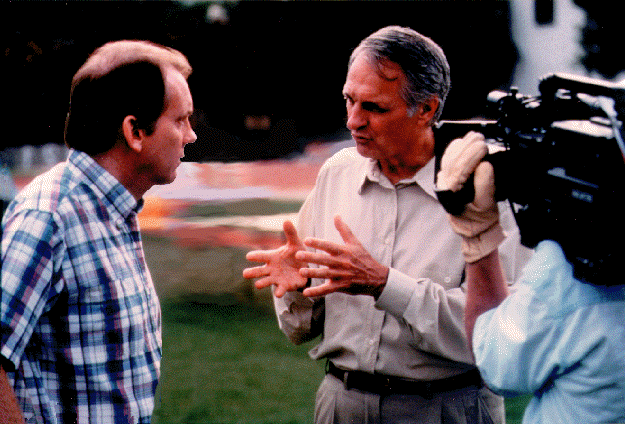The International Aerial Robotics Competition
 The International Aerial Robotics (IARC) has been a topic of media interest for more than 25 years. The IARC has been instrumental in bringing AUVSI and the field of aerial robotics to the forefront of cultural awareness through not only mass media such as the various Discovery and Scientific American Frontiers specials which have focused on the IARC, but also through its reach to over one billion people in 2015 as it was televised across all of Asia by China Central Television (CCTV). The IARC has appeared on television, radio, and in print media
(see an abbreviated list here).
The International Aerial Robotics (IARC) has been a topic of media interest for more than 25 years. The IARC has been instrumental in bringing AUVSI and the field of aerial robotics to the forefront of cultural awareness through not only mass media such as the various Discovery and Scientific American Frontiers specials which have focused on the IARC, but also through its reach to over one billion people in 2015 as it was televised across all of Asia by China Central Television (CCTV). The IARC has appeared on television, radio, and in print media
(see an abbreviated list here).
The International Aerial Robotics Competition (IARC) was conceived by Professor Robert C. Michelson of the Georgia Institute of Technology shortly after election to the AUVSI Board of Directors in 1990. He recounts, "As the new Technical Chairman for the AUVSI Board, I had the opportunity to do something that I had hoped to do at Georgia Tech, but for which there was no funding. That was to create the world's first aerial robotics competition with a mission that was impossible at the time, but technically feasible, and then let university teams from around the world attempt to master the challenge."
The International Aerial Robotics Competition has now entered its second quarter century of operation, and has been responsible for moving the state of the art in aerial robotics forward on several occasions as various undergraduate and graduate university teams from around the world demonstrated the impossible.
In a briefing to Newt Gingrich in March of 1999 at Georgia Tech's Research Institute, Prof. Michelson explained the concept of the 'technology competition' and showed some of the stellar results achieved to date. Later in an invited keynote speech to the National Academy of Engineering's Workshop on Government-Sponsored Technology Prizes and Contests, Gingrich used the International Aerial Robotics Competition as an "example of an effective technology-advancing contest" that "accurately portrayed the high degree of innovation young future engineers have when given an outlet and challenge." Since Gingrich's keynote, we have seen a proliferation of events involving autonomous vehicles, most notably the DARPA Grand Challenge, NASA competition announcements, and various international micro air vehicle demonstrations sponsored by the U.S. Army RDECOM which Michelson helped to organize based on his unique experience with the IARC. In fact, the AUVSI Foundation and RoboNation offer a number of robotics competitions such as the Intelligent Ground Vehicle Competition (IGVC) and the Student Unmanned Aerial Systems Competition (SUAS) which appeal to high school students, and were spawned by the Association's inaugural university-only event, the International Aerial Robotics Competition.
Dr. Edward Teller, father of nuclear weaponry, stated in a 1981 press conference that "the unmanned vehicle today is a technology akin to the importance of radars and computers in 1935." Michelson says, "That being the case, then I believe the unmanned vehicles of Teller's day will be seen as the progenitors of an astonishing new class of mobile "thinking" machines able to assemble disparate data from an array of sensors and intelligently draw conclusions upon which to act with the adeptness and fallibility of a human. Among this class of mobile thinking machines are aerial robots, which require the greatest sophistication due to their degrees of freedom, instability under most conditions, potential speed, and requirement for rapid correct decisions coupled with a high cost for failure."
The most surprising thing to come out of the International Aerial Robotics Competition has been the fact that the student teams do not compete against one another, rather, they compete against the mission. Time and again, the teams pitch in to help each other when there are technical problems or when replacement components are needed on the spot. Michelson says, "I have witnessed teams jumping in to reprogram and save another team's errant vehicle that was flying off into the sunset with limited fuel, and no hope of return. Rather than allow a spectacular crash, competitors worked furiously to save the team in distress. This kind of unwarranted selfless behavior made me proud to have assembled such great minds from around the world to focus on a common challenge— where beating the challenge was more important that winning thousands of dollars in prize money."
While President of the Association for Unmanned Vehicle Systems (AUVS), the organization was expanded in scope on Michelson's watch to become more international, and the word "International" was added to the name. At the same time, the non-profit Association for Unmanned Vehicle Systems International Foundation was created, which now oversees the university-based land, sea, undersea, and air competitions as well as the National SeaPerch Challenge (a STEM program). Of all of these competition-related efforts, the International Aerial Robotics Competition has been the one effort that has truly put the "I" in AUVSI by expanding to the point that it is conducted annually at two venues -- one on each side of the planet. The American Venue is currently held on the campus of the Georgia Institute of Technology and the Asia/Pacific Venue is held in Beijing China. As a example, the slate of teams in the competition's 25th year, hailed from not only the United States and China, but also from Norway, Spain, Iran, India, Egypt, Dubai, Canada, Turkey, Singapore, and Nepal.